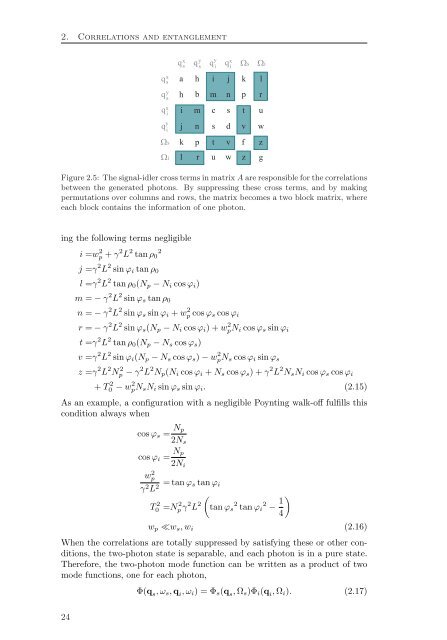Spatial Characterization Of Two-Photon States - GAP-Optique
Spatial Characterization Of Two-Photon States - GAP-Optique
Spatial Characterization Of Two-Photon States - GAP-Optique
Create successful ePaper yourself
Turn your PDF publications into a flip-book with our unique Google optimized e-Paper software.
2. Correlations and entanglement<br />
q s x<br />
q s y<br />
q i x<br />
y<br />
qi s<br />
i<br />
qs x<br />
a<br />
h<br />
i<br />
j<br />
k<br />
l<br />
q s<br />
y<br />
h<br />
b<br />
m<br />
n<br />
p<br />
r<br />
qi y<br />
i<br />
m<br />
c<br />
s<br />
t<br />
u<br />
Figure 2.5: The signal-idler cross terms in matrix A are responsible for the correlations<br />
between the generated photons. By suppressing these cross terms, and by making<br />
permutations over columns and rows, the matrix becomes a two block matrix, where<br />
each block contains the information of one photon.<br />
ing the following terms negligible<br />
i =w 2 p + γ 2 L 2 tan ρ0 2<br />
j =γ 2 L 2 sin ϕi tan ρ0<br />
l =γ 2 L 2 tan ρ0(Np − Ni cos ϕi)<br />
m = − γ 2 L 2 sin ϕs tan ρ0<br />
q i<br />
x<br />
n = − γ 2 L 2 sin ϕs sin ϕi + w 2 p cos ϕs cos ϕi<br />
r = − γ 2 L 2 sin ϕs(Np − Ni cos ϕi) + w 2 pNi cos ϕs sin ϕi<br />
t =γ 2 L 2 tan ρ0(Np − Ns cos ϕs)<br />
v =γ 2 L 2 sin ϕi(Np − Ns cos ϕs) − w 2 pNs cos ϕi sin ϕs<br />
z =γ 2 L 2 N 2 p − γ 2 L 2 Np(Ni cos ϕi + Ns cos ϕs) + γ 2 L 2 NsNi cos ϕs cos ϕi<br />
j<br />
n<br />
s<br />
d<br />
v<br />
w<br />
+ T 2 0 − w 2 pNsNi sin ϕs sin ϕi. (2.15)<br />
As an example, a configuration with a negligible Poynting walk-off fulfills this<br />
condition always when<br />
cos ϕs = Np<br />
2Ns<br />
cos ϕi = Np<br />
2Ni<br />
w 2 p<br />
γ 2 L 2 = tan ϕs tan ϕi<br />
T 2 0 =N 2 p γ 2 L 2<br />
wp ≪ws, wi<br />
s<br />
k<br />
p<br />
t<br />
v<br />
f<br />
z<br />
i<br />
l<br />
r<br />
u<br />
w<br />
<br />
tan ϕs 2 tan ϕi 2 − 1<br />
<br />
4<br />
z<br />
g<br />
(2.16)<br />
When the correlations are totally suppressed by satisfying these or other conditions,<br />
the two-photon state is separable, and each photon is in a pure state.<br />
Therefore, the two-photon mode function can be written as a product of two<br />
mode functions, one for each photon,<br />
24<br />
Φ(q s, ωs, q i, ωi) = Φs(q s, Ωs)Φi(q i, Ωi). (2.17)



